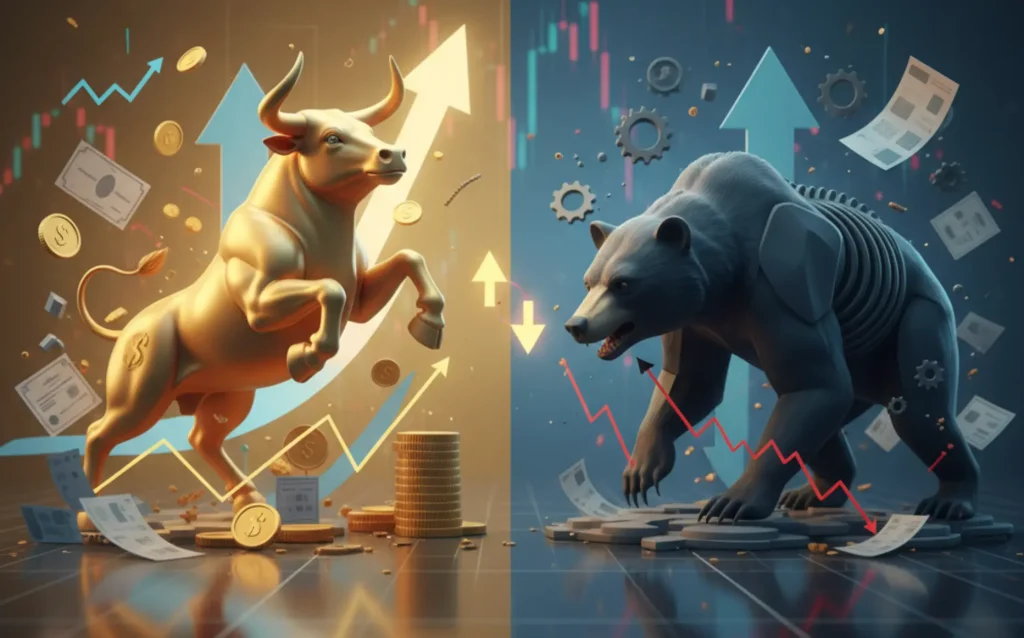Markets are rarely unanimous. While many hedge fund managers remain cautious, opportunities continue to emerge for those willing to look beyond fear.
At the start of 2025, the consensus among institutional investors was pessimistic. Fund managers worried about rising U.S. inflation, the impact of high interest rates, and the possibility of a recession triggered by trade tariffs promised by President Trump.
Given this climate, it was no surprise that many expected a significant market correction—or even the early stages of a new bear market, despite the downturn of 2022 still fresh in memory.
Why So Much Pessimism?
The cautious stance of hedge funds and asset managers rested on three main concerns:
- Inflation pressures. Rising consumer prices reduce purchasing power and can force the Federal Reserve to maintain tighter monetary policy.
- High interest rates. Prolonged periods of elevated rates slow borrowing, investment, and consumer spending, raising fears of recession.
- Trade uncertainty. Proposed tariffs created new risks for global supply chains and U.S. exporters, introducing another layer of unpredictability.
For many professionals, these risks made equities look vulnerable, reinforcing a defensive mindset.
My Initial Positioning in 2025
Influenced by these same risks, I also began the year cautiously. I focused on hedging strategies and kept a more conservative allocation than usual.
While this offered protection, it also meant I participated less in the early 2025 rally. Even as markets gained ground, I chose not to increase my exposure, preferring to wait for what I believed would be a better entry point. Looking back now, it seems any significant correction may only arrive at higher market levels.
The Power of “Animal Spirits”
One factor that continues to surprise many market watchers is resilience driven by what legendary investor Stanley Druckenmiller once described as “animal spirit.”
This phrase captures the psychological shift that happens when optimism overtakes fear. Druckenmiller himself highlighted how moving from an anti-business environment to a highly pro-business administration transformed business leaders’ outlook.
- Caution gave way to confidence.
- Optimism spurred more investment and hiring.
- Growth reinforced itself in a positive feedback loop.
Even previously bearish investors are being drawn back into the market, reassessing their stance despite real risks and elevated valuations.

Why Market Timing Falls Short
This experience reinforced a lesson I’ve learned many times: predicting market direction is nearly impossible.
Instead of trying to outguess macroeconomic shifts, I prefer to:
- Focus on high-quality stocks with strong fundamentals.
- Use hedging strategies with options to manage downside risk.
This approach means that even when new positions haven’t yet delivered profits, I remain confident because my downside is limited. Protection allows me to stay invested rather than being paralyzed by fear.
Avoiding Premature Selling
Another valuable takeaway has been resisting the temptation to sell high-quality holdings too soon.
At the start of the year, I did not aggressively add new exposure, but I also avoided selling out of fear. That decision paid off: by January, my portfolio had gained more than 9%. Selling early would have cost me those gains.
This underlines a key principle: fear-driven selling is often more damaging than market volatility itself.
The Extraordinary Decade Ahead
Looking forward, I believe we are in a truly unique moment. Two powerful forces are converging:
- A pro-business political environment. Business leaders are more confident, spurring investment and innovation.
- The AI revolution. Artificial Intelligence is reshaping industries the same way the internet did in the 1990s.
We’ve already seen massive moves in companies like NVIDIA (NVDA), Applovin (APP), and Super Micro Computer (SMCI). These stocks show how innovation can fuel explosive growth, and I believe many more opportunities will emerge across technology and related sectors.
Cryptocurrencies may also continue to play a role as complementary growth assets, though with higher volatility.
Navigating Inevitable Corrections
Of course, corrections and downturns are unavoidable. Over the next decade, we will experience both bull and bear markets—sometimes sharp, sometimes prolonged.
The key is to stay focused on:
- High-quality, innovative companies with strong fundamentals.
- Options-based hedging strategies that act like insurance.
This balance allows us to remain positioned for growth while reducing the risks that come with volatility.
Why Optimists Win More Often
Stepping back, I’m reminded of a simple but powerful truth: optimists tend to build more wealth than skeptics.
- Skeptics often focus on what could go wrong and hesitate.
- Optimists acknowledge risks but act when opportunities arise.
Discipline, quality, and risk management matter—but above all, it is optimism with preparation that creates the biggest rewards.
Related Reading: Explore More Investment Insights
If this article resonated with you, take a look at our other pieces:
- Hedging with Options vs. Short Selling – A guide to two of the most common defensive strategies.
- Adaptability Has Always Been Key — But in an AI-Driven World, It Becomes Essential – Why flexibility matters more than ever in investing and careers.
- Medium-Term Investing: How to Ride Big Market Trends and Build Long-Term Wealth – Learn why capturing multi-month moves can be more effective than short-term trading.
Final Thoughts
As we move through 2025, the market remains full of uncertainty—but also full of opportunity. Rising inflation, interest rates, and tariffs pose challenges. Yet optimism, innovation, and the transformative power of AI may more than offset those risks.
So I leave you with a question:
Are you letting macro fears control your decisions—or are you preparing to seize the opportunities of this extraordinary moment in history?
Disclaimer: This article is for informational and educational purposes only. It does not constitute financial, investment, or legal advice, and should not be taken as a recommendation to buy, sell, or hold any asset. Always conduct your own research and consult with a qualified professional before making any financial decisions. The author and publisher are not responsible for any actions taken based on the information provided in this content.
